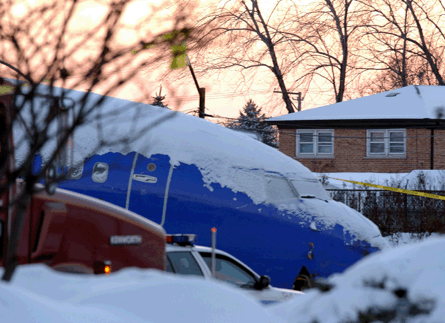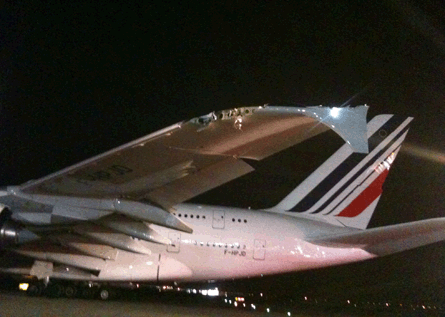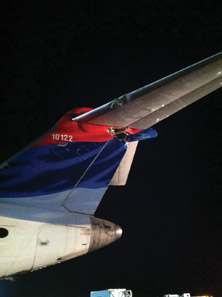Could the fatal overrun of a Southwest Airlines Boeing 737 at Chicago Midway in 2005 or the non-fatal but high-profile taxiway prang between an Air France Airbus A380 and Comair Bombardier CRJ at New York's John F Kennedy airport in April this year have been predicted? Creative new ways to analyse the reams of digital avionics data may answer those questions in the affirmative.
Saab Sensis is making headway on tagging accident precursors from surveillance data at airports, an analogue of the airborne flight operations quality assurance (FOQA) programme that monitors flight data recorder data. As part of its work within the US Federal Aviation Administration's aviation safety information analysis and sharing programme, Saab Sensis has been investigating "offshoot" uses of its airport surface detection equipment (ASDE-X) surveillance system, in place at 35 major airports in the USA. ASDE-X predicts where runway incursions might happen by fusing information primarily from multilateration sensors and surface-movement radar systems.
 |
|---|
© Rex Features One fatality resulted from this 2005 overrun |
Ben Levy, manager of the operations research group at Saab Sensis, says the company took the technology a step further by analysing all aircraft movements - to and from the runway, starting and ending at the gate - at three ASDE-X airports. The initial product, called Airport Viewer, is not intended to create real-time alerts but to look at ASDE-X data from weeks, months or years of operations to spot problem areas based on taxiing or driving performance of pilots, airport tug operators, snow removal vehicles, aircraft servicers or anything else tracked by surveillance assets.
AIRPORT DEVELOPMENT
To get a full picture of whether potential issues are real and how serious they might be, researchers added linked-in details such as radio conversations, weather data, aircraft databases, aircraft images and facility maps. The benefits can also be applied to airport development or improvement programmes. Initially, Sensis analysed eight weeks of ASDE-X data from JFK, Miami and Memphis. "We came up with 10 to 15 types of events that we could identify, including sudden stops and large deceleration traces," says Levy.
Engineers presented potential problems to air traffic controllers, who helped to select the highest-priority safety items - sudden stops, route excursions, and irregular turns. Engineers are now looking at a year's worth of data from JFK, while planning to start taking shorter-term snapshots of more airports that are equipped with ASDE-X.
After studying the eight weeks of data from JFK, Airport Viewer identified 400 of what it considered "high priority" anomalies, half of which were categorised as the most consequential. "We're now working with the algorithms to catch only those," says Levy. "The 200 looked real though - slamming on brakes, pilots who appear lost or were taking a strange routing - events you would want to investigate further."
TARMAC ANOMALIES
Levy says the tool - which estimates a collision risk and is not dependent on human data entry - would ultimately fit into an airport's safety management system to keep a running tally of the selected tarmac anomalies. "We first search through a large set of data for the airport and identify to local experts problems in the anomalies," says Levy. "Could it be due to signage?" He adds that the tool "really comes to fruition" when there is a "rate of change" for a particular anomaly in a certain location.
A new flight data recorder prognostics tool developed by the Massachusetts Institute of Technology (MIT) may have prevented an airport disaster unlinked to taxiways. According to MIT graduate student Lishuai Li, a cluster analysis tool she has developed with MIT professors, including John Hansman and others in Spain, could have foreseen the fatal accident based on pilot performance captured by FOQA data.
The US National Transportation Safety Board determined that the pilots of Southwest Flight 1248 - which overran by 150m (500ft) from a runway at Chicago's Midway airport in a snowstorm on a December night in 2005 - failed to use thrust reversers "in a timely manner". One person was killed when the twinjet crushed a car.
Li says the anomaly detection algorithm - which uses so-called cluster analysis to find outliers in otherwise subsets of common patterns for flights - may have netted late thrust-reverser actuations in previous flights. The critical assumption is that similar delays in deploying thrust reversers had occurred enough times for a cluster analysis to have alerted the airline to the problem. MIT says the software applies a customising cluster analysis - a common statistical tool - to flight data recorder output. Flight parameters are "mapped" into a vector for each of the flights. Then, when plotted together in a common frame, the outlier flights separate from the cluster of normal flights, signalling potential problems which can then be studied. The beauty of this method is that safety officials need no prior knowledge of a particular problem as the software flags potential dangers if a flight differs from its normal pattern.
The cluster analysis goes beyond FOQA, which typically calls for the monitoring of a "watch list" of 88 flight parameters on each flight, mostly linked to crew performance. These include pitch angle, take-off and landing speed, and when pilots retract the flaps. Obtaining FOQA information to analyse has been problematic in the past and remains so for MIT, as unions are protective of data for fear of crews being penalised.
FLIGHT ABNORMALITIES
Hansman, professor of aeronautics and astronautics and engineering systems at MIT, says the amount of data dedicated to FOQA has risen dramatically thanks to an increase in sensors and data storage capacity. This is a boon for safety analysis but can be problematic when determining which data are important.
He notes that the Boeing 787 is able to record 2,000 flight parameters continuously for up to 50 hours, prompting the need for careful assessment of the threshold for defining something as potentially problematic. "If you're looking at [an] airline flying 1,000 flights a day and we flag [abnormalities in] 1% of those, that's 10 flights a day someone has to look at," says Hansman. "We want to be more discriminating. Once you get a safety analyst to say something is unusual but is safe, you may be able to count [the occurrence] but maybe not flag it in subsequent analysis."
 |
|---|
 |  |
|---|
An A380's wingtip sliced into the T-tail of a Comair CRJ at JFK airport on 11 April |
MIT researchers tested the technique on flight data from 365 flights during one month. The airline flew Boeing 777s, but is no longer operating. Each flight included measurements taken at one-second intervals, including aircraft position, speed, acceleration, wind speed, and environmental pressure and temperature, says MIT.
The work is being funded by the FAA as part of a joint air transport research programme that also includes Ohio State University and Princeton University. Results showed that several flights "stuck out from the normal cluster" for the take-off and landing portion, says Hansman.
Further investigation determined that crew actions caused the apparent anomalies, including one case where a flight took off with "significantly less power than most", indicating either an incorrect thrust setting by the crew or a potential power system issue.
The team found another take-off exhibited erratic pitch behaviour, indicating that the pilot had difficulty rotating on take-off. A third flight flew low on approach with a higher-than-normal flap setting, creating drag that forced the application of more thrust than usual before landing, says MIT.
Hansman says he is talking to several airlines and NASA to obtain additional FOQA data to test. During the next few months, MIT will test its cluster analysis on data provided by NASA's Ames Research Center, where researchers are developing similar data-mining programs for FOQA.
"We're going to run the same set of data and see how the results compare," says Hansman, noting that the work has to be carried out at Ames as the proprietary data from airlines are strictly controlled.
Saab Sensis, meanwhile, is looking for additional airports to test Airport Viewer. The long-term vision for the tool includes use as an airport design aid, where airport taxi performances can be monitored to determine best practice for future airport layouts, says Levy.
While Levy was not at liberty to say whether Airport Viewer had picked up on issues from taxiway M near gate 23 at JFK - where the A380's wingtip sliced into the T-tail of the Comair CRJ on 11 April - he says he has seen "anomalies that take place in the data before actual incidents that are very similar".
Source: Flight International



















